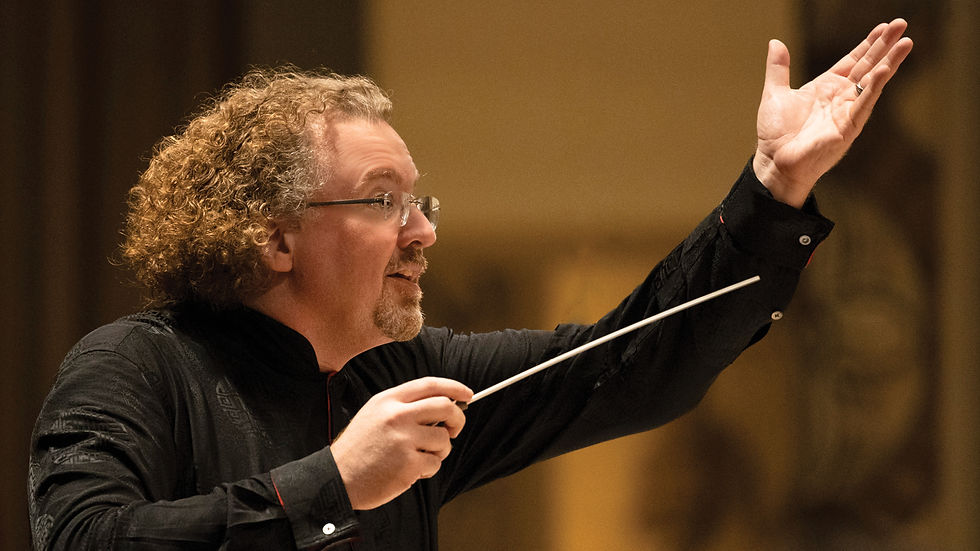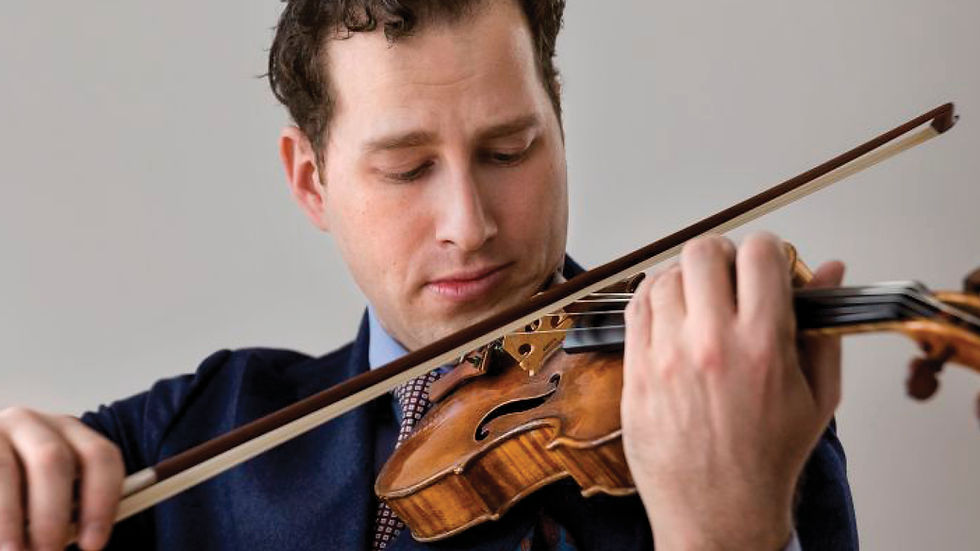Program Notes: Tchaikovsky's Fourth (September 25-26, 2021)
- SLSO
- Sep 21, 2021
- 6 min read
Program
Stéphane Denève, conductor
Inbal Segev, cello
Kirven Douthit-Boyd, choreographer Geoffrey Alexander, dancer
Carly Vanderheyden, dancer Cici Gregory, dancer Gabriella (Gabby) Billy, dancer Antonio Douthit-Boyd, dancer
John Stafford Smith
arranged John Philip Sousa and Walter Damrosch The Star Spangled Banner (1814)
Jessie Montgomery
Banner (2014)
Anna Clyne
DANCE (2014)
when you're broken open
if you've torn the bandage off in the middle of the fighting in your blood when you're perfectly free
Inbal Segev, cello
Kirven Douthit-Boyd, choreographer Geoffrey Alexander, dancer
Carly Vanderheyden, dancer Cici Gregory, dancer Gabriella (Gabby) Billy, dancer Antonio Douthit-Boyd, dancer
Pyotr Ilyich Tchaikovsky
Symphony No. 4 (1877)
Andante sostenuto; Moderato con anima
Andantino in modo di canzona Scherzo. Pizzicato ostinato: Allegro Finale: Allegro con fuoco
Program Notes
By Tim Munro
Stéphane on this program
This program is about change and resilience. About giving a hope that we will overcome our fate.
Jessie Montgomery’s Banner interrogates the meaning of our national anthem. She intertwines “The Star-Spangled Banner” with many anthems, including the Black national anthem, “Lift Every Voice and Sing.”
Jessie’s music evokes of the sound and structure of marching band music. There is a musical interpretation of the Pledge of Allegiance that imitates the sound of a crowd, so the musicians are not perfectly in sync.
Banner is beautifully made, there is a real musical logic. Jessie is a great composer already, and it’s exciting to imagine how she will grow in the future. Anna Clyne’s DANCE is inspired by a poem by Rumi. The word “dance” is repeated almost as a kind of mantra. Anna responds with music that reaches for the spiritual, it is expressive and accessible.
I want to connect with institutions in the St. Louis community. In DANCE, we collaborate with Kirven and Antonio Douthit-Boyd, Co-Artistic Directors of Dance at the Center of Creative Arts (COCA). Dance and music have the same expression of freedom. We explore the space—make it vibrate with beauty.
I conducted Pyotr Ilyich Tchaikovsky’s Fourth Symphony on my very first visit to St. Louis in 2003. It asks the biggest question: What is a life?
Tchaikovsky’s musical voice goes directly to your heart. It is the incredible power of empathy; you feel as if you’ve lived the emotions he’s expressing. And his music is crafted so perfectly, there’s not a note out of place.

Banner
Jessie Montgomery
Born 1981, New York, New York
As a composer, Jessie Montgomery is searching for ways to create dialogue. “I imagine that music is a meeting place,” she has said, “at which all people can converse about their unique differences and common stories.”
Banner was commissioned to mark the 200th anniversary of the “The Star- Spangled Banner.” Montgomery felt conflicted about the commission. “I have a complicated relationship with the anthem. As an African American person living in the United States, I have never felt that the song applied to me.”
Banner proposes a new anthem, one “that represents where we are now, in this multifaceted, multicultural melting pot.” It weaves together twelve pre-existing melodies: anthems from neighboring countries, work songs, and freedom songs.
At its center is “Lift Every Voice and Sing” by James Weldon Johnson, the Black National Anthem. It is a song with deep roots in the SLSO community: the SLSO’s annual Lift Every Voice concert, performed with the IN UNISON Chorus, is named for James Weldon Johnson’s composition.
“A tribute to the U.S. National Anthem,” writes Montgomery, “means acknowledging the contradictions, leaps and bounds, and milestones that allow us to celebrate and maintain the tradition of our ideals.”
First performance: September 2014, by the Sphinx Virtuosi, in Miami, Florida
FirstSLSO performance: This weekend’s concerts
Instrumentation: 2 flutes (2nd doubling piccolo), oboe, clarinet, bassoon, horn, trumpet, timpani, percussion (kick drum, snare drum, tom-tom), strings Approximate duration: 8 minutes

DANCE
Anna Clyne
Born March 9, 1980, London, England
We dance in joy, throwing ourselves around a room. We dance in sadness, moving with heavy limbs. We dance in worship, twirling and twirling.
Dance is core to who we are. Early humans likely used movements as a communication or bonding tool. Research suggests that babies are born with the innate ability to dance.
Dance was central to the creative and spiritual process of Jalal ad-Din Muhammad Rumi, the 13th century Sufi mystic. His dances allowed him to enter the ecstatic states that inspired his writing. Later, his teachings gave birth to the dervishes, a Muslim order that use a spinning dance to reach closer to God.
Anna Clyne’s composition studio is dotted with hand-written notes, photo- graphs, art works. For her, inspiration comes from many places. Clyne can often be found dancing late at night, while listening to a draft of a new piece.
The titles of the five sections of Anna Clyne’s DANCE are each take by a line of Rumi’s short poem, “Dance:”
Dance, when you’re broken open. Dance, if you’ve torn the bandage off. Dance in the middle of the fighting. Dance in your blood. Dance, when you’re perfectly free.
Clyne was drawn to the “evocative language” of Rumi’s poem. In the first movement, “When you’re broken open,” Clyne imagines a shattered object, its fragments illuminated, glowing like embers.
The soloist in DANCE plays Clyne’s own instrument, the cello. She exploits the emotional range of the instrument: floating, fighting, wailing, running. In the final movement, “When you’re perfectly free,” the cello sings a melody—ancient, ecstatic—above the orchestra.
First performance: August 3, 2019, by the Cabrillo Festival Orchestra, in Santa Cruz, California, Cristian Măcelaru conducting, with Inbal Segev as soloist First SLSO performance: This weekend’s concerts, which are also the first choreographed performances of this work
Instrumentation: solo cello, 2 flutes (2nd doubling piccolo), 2 oboes (2nd doubling English horn), 2 clarinets (2nd doubling bass clarinet), bassoon, contra- bassoon, 2 horns, 2 trumpets,trombone, tuba, timpani, percussion (crotales with bow, marimba, suspended cymbal, tam tam, vibraphone with bow, wind machine), harp, strings
Approximate duration: 25 minutes

Symphony No. 4
Pyotr Ilyich Tchaikovsky
Born May 7, 1840, Votkinsk, Russia Died November 6, 1893, Saint Petersburg, Russia
At 37, Pyotr Ilyich Tchaikovsky rushed into marriage. At the time, he had achieved some measure of professional success, but rumors spread about his personal life. Marriage seemed to offer him stability, respectability, and freedom from questions about his sexuality.
Tchaikovsky and Antonina Milyukova were a terrible match. She, filled with youthful passion for him. He, haughty, superior, and cold to her. The marriage lasted only a month. Tchaikovsky, who attempted suicide soon after the wedding, fled from Milyukova.
The Fourth Symphony was written during this turbulent period. In a letter to his patron, Nadezhda von Meck, he wrote that the work was “an unburdening of the soul in music.”
In Russia, the symphony as a form was in its infancy. The country was opera- and ballet-mad, in love with page-turning stories and glittering spectacles. Tchaikovsky was part of a new generation filling the hallowed halls of the symphony with dark Russian colors.
After completing the symphony, he wrote to von Meck, laying out the private feelings that roiled beneath the symphony’s surface. Below are extracts from this letter:
I. The seed of the symphony is Fate: a force ensuring that happiness cannot be unclouded. A sweet daydream appears—some blissful, radiant human image. But no! Fate wakes us. Life is an alternation of harsh reality with fleeting visions of happiness. No haven exists.
II. An expression of melancholy, like an evening alone with a book. Memories appear: happy moments when young blood boiled, and life was satisfying. There are also painful memories, irreconcilable losses. It is sad yet sweet to be immersed in the past.
III. Whimsical arabesques, vague images sweep past the imagination. Suddenly, a picture of drunken peasants and a street song. Somewhere in the distance, a military procession. They are images which sweep through the head as one falls asleep: strange, wild, and incoherent.
IV. Go out among the people. See how they enjoy themselves, surrendering to joyful feelings. Fate appears and reminds you of yourself. Others don’t care— they have not noticed that you are sad. Their joy is a simple but powerful force. You must rejoice in the rejoicing of others. To live is still possible.
First performance: February 22, 1878, by the Russian Musical Society, in Moscow, Nikolai Rubinstein conducting First SLSO performance: January 23, 1905, Alfred Ernst conducting Most recent SLSO performance: November 12, 2017, John Storgårds conducting Instrumentation: 2 flutes, piccolo, 2 oboes, 2 clarinets, 2 bassoons, 4 horns, 3 trumpets, 3 trombones, tuba, timpani, percussion (bass drum, cymbals, triangle), strings Approximate duration: 44 minutes
Tim Munro is the St. Louis Symphony Orchestra’s Creative Partner. A writer, broadcaster, and Grammy-winning flutist, he lives in Chicago with his wife, son, and badly behaved orange cat.
The concerts of September 25 and 26 are the Loren and Ken Ludmerer Endowed Concerts. The concert of Saturday, September 25 is underwritten in part by generous gifts from
Mr. and Mrs. Barry H. Beracha, Mr. and Mrs. Walter J. Galvin, and Mr. and Mrs. David L. Steward.
The concert of Sunday, September 26 is underwritten in part by a generous gift from Mr. and Mrs. Jack Bodine and Susan and Stuart Keck.
Program Notes are sponsored by Washington University Physicians.




Love the electronic program notes but prefer the downloadable version you had before they were more complete.